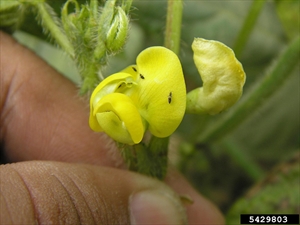Bean flower thrips. It is also known as the Oriental bean thrips, Asian bean thrips.
Pacific Pests, Pathogens, Weeds & Pesticides - Online edition
Pacific Pests, Pathogens, Weeds & Pesticides
Bean flower thrips (342)
Megalurothrips usitatus; previously known as Taeniothrips nigricornis
Asia, Oceania. It is recorded from Australia, Fiji1, French Polynesia, Kiribati, Papua New Guinea, Tonga, and Tuvalu.
Mostly members of the bean family (Fabaceae); common hosts are cowpea, French bean, pea, peanut, pigeon pea, mung bean, and soybean.
Thrips damage the pods of beans. Infestations begin in the flowers (Photo 1), and pods become twisted, deformed with reddish-brown russet marks as the thrips feed. Large infestations cause poor pod set, stunted plants, and leaves and flowers to wilt. This species of thrips is not known to spread viruses.
Eggs are laid in slots flowers and leaves cut with the ovipositor; nymphs are yellow at first, but later deep yellow or orange-red. Pupae are formed in the soil. Adults and nymphs are readily seen when opening the flowers. The adults are greyish-brown, with deepest colours on the head and striped abdominal segments (Photo 2).
Spread is by active flight, but also winged adults and nymphs can be picked up by winds and carried long distances.
It is not a major pest of beans in Fiji and it is only occasionally so in Asia. The related species Megalurothrips sjostedtiis considered much more important. In Java, for instance, Megalurothrips usitatus was common on soybean, but crop yields were not affected. In contrast, a 30% yield loss in peanut was recorded in Taiwan, but Megalurothrips usitatus was not the only species present.
Look for the wilting of flowers and leaves, and adult thrips, and nymphs, in the flowers. Because of similarity of Megalurothrips usitatus with other species, specimens should be sent for expert identification. Sticky traps are used to monitor and control some species of thrips, and could be tried for this species.
NATURAL ENEMIES
Several natural enemies feed on thrips. There are predatory thrips, minute pirate bugs, predatory mites, lacewing larvae and ladybird beetles (adults and larvae). Parasitoids have been report (eulophids), but their impact is not well known.
Note, it is best to avoid pesticides to manage thrips, especially those pesticides that are long lasting, as they will destroy populations of beneficial insects. Also, thrips develop resistance to pesticides easily.
CULTURAL CONTROL
Before planting:
- Avoid planting next to infested crops.
- Rotate crops with non-host plants to break the lifecycle. Avoid planting another food legume crop after beans.
During growth:
- Intercrop with a non-host plant to slow the movement of thrips through the crop. For example, grow capsicum between yard-long beans.
- Destroy weeds within and around crops to prevent build-up of thrips populations.
- Use a hose with a strong jet of water to remove thrips from the plants.
After harvest:
- Destroy crop remains after harvest to prevent thrips spreading from old to young crops.
CHEMICAL CONTROL
It is unlikely that thrips populations will be high enough to justify use of pesticide. In any case, the use of pesticides is likely to do more harm than good, as they will kill natural enemies. Also, thrips tend to hide in sheltered places on plants, and within flower buds they are difficult to reach with pesticides. If pesticides are applied, try plant-derived products (botanical sprays) first, and always try to treat the undersides of the leaves. Do the following:
- Use plant-derived pesticides, such as derris, chilli, garlic, onion and papaya (see Fact Sheet no. 56). The toxicity of these PDPs is lost within a few days in sunlight.
- Alternatively, and possibly a better choice, is to use horticultural oil (made from petroleum), white oil (made from vegetable oils), or soap solution (see Fact Sheet no. 56).
- White oil:
- 3 tablespoons (1/3 cup) cooking oil in 4 litres water
- ½ teaspoon pure hand soap, not detergent
- Shake well and use.
- Soap:
-
Use soap (pure soap, not detergent).
- 5 tablespoons of soap in 4 litres water.
-
- White oil:
- Commercial horticultural oil can also be used. White oil, soap and horticultural oil sprays work by blocking the breathing holes of insects causing suffocation and death. Spray the undersides of leaves; the oils must contact the insects. A second application of soap or oils may be necessary after 3-4 weeks.
- Use neem to discourage adults from feeding and laying their eggs on the plants (see Fact Sheet no. 56).
- Do not use broad-spectrum insecticides such as dimethoate (under review in Australia, and not allowed for use in home gardens), malathion and permethrin. They have a greater effect on the natural enemies of thrips than on the thrips.
--------------------
Note, derris (Derris species) contains rotenone, an insecticide, often used as a fish poison; it should be used with caution. The commercial derris insecticide is made from Derris elliptica.
____________________
When using a pesticide, always wear protective clothing and follow the instructions on the product label, such as dosage, timing of application, and pre-harvest interval. Recommendations will vary with the crop and system of cultivation. Expert advice on the most appropriate pesticides to use should always be sought from local agricultural authorities.
AUTHOR Grahame Jackson
1Information from Swaine G (1971) Agricultural Zoology in Fiji. Her Majesty's Stationery Office. London; and CABI (2019) Megalurothrips usitatus (bean flower thrips) Crop Protection Compendium. (https://www.cabi.org/cpc/datasheet/33140); and from Bean flower thrips (Megalurothrips usitatus) Plantwise Knowledge Bank. (http://www.plantwise.org/KnowledgeBank/Datasheet.aspx?dsID=33140). Photo 1 Desley Tree (2010) Oriental bean flower thrips, Asian bean thrips (Megalurothrips usitatus): PaDIL - (http://www.padil.gov.au). Photo 2. Ko Ko Maung, Bugwood.org.
Produced with support from the Australian Centre for International Agricultural Research under project PC/2010/090: Strengthening integrated crop management research in the Pacific Islands in support of sustainable intensification of high-value crop production, implemented by the University of Queensland and the Secretariat of the Pacific Community.





